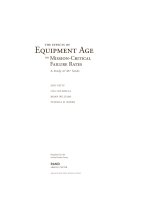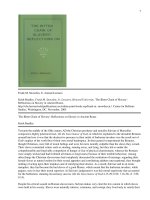Influences of pH Values on Magnetic CoNiP Nanowires Fabrication
Bạn đang xem bản rút gọn của tài liệu. Xem và tải ngay bản đầy đủ của tài liệu tại đây (359.06 KB, 5 trang )
<span class='text_page_counter'>(1)</span><div class='page_container' data-page=1>
54
Influences of pH Values on Magnetic CoNiP
Nanowires Fabrication
Luu Van Thiem
1,3, Le Tuan Tu
2,* , Pham Duc Thang
1<i> 1<sub>Faculty of Engineering Physics and Nanotechnology, VNU University of Engineering Technology, </sub></i>
<i>144 Xuan Thuy, Cau Giay, Hanoi, Vietnam </i>
2<i><sub>Faculty of Physics, VNU University of Science, 334 Nguyen Trai, Thanh Xuan, Hanoi, Vietnam </sub></i>
<i>3<sub>Faculty of Basic Science, Hanoi Industrial College for Textile, Garment and Fashion, </sub></i>
<i>Le Chi, Gia Lam, Hanoi, Vietnam </i>
Received 08 April 2014
Revised 20 May 2014; Accepted 19 June 2014
<b>Abstract: CoNiP nanowire arrays were fabricated by electrodeposition method into polycarbonate </b>
(PC) templates at different pH values. It is obvious that the crystal structure of the CoNiP
nanowires depends on the pH values of electrolyte. The XRD results show that crystal structure of
the CoNiP nanowires is hcp structure and the intensity of the hcp (002) increased enhances as
solution pH=3.5. Magnetic measurements indicate that CoNiP nanowires show a transition from soft
to hard magnetic properties with pH values from 2.0 to 3.5 and the maximum coercivity is 1630 Oe.
<i>Keywords: PC template, CoNiP nanowires, magnetic properties and electrodeposition. </i>
<b>1. Introduction*</b>
Magnetic nanowires have received much attention in the last few years because of their unique
magnetic properties and application potential for cell separation, biosensing and gene delivery [1- 4].
Hultgren et al studied the application of Ni nanowires in cell separation [5]. It was found that high
purity separations can be achieved for nanowires over a wide range of size, while the optimum
separation yield is achieved when the average length of the nanowires matches the average diameter of
the cell. In fact, the magnetic properties of magnetic nanowires are related to many parameters of the
nanowire, such as length, diameter and composition. To date, many different techniques have been
employed to produce nanoscaled materials. Among them, the electrodeposition of nanowires into
polycarbonate template is a simple, low cost and operates at room temperature. Template synthesis
based on ordered polycarbonate membrane has attracted much interest because of their wide
application in fabricating nanowire and nanotube arrays [6]. Therefore, Ni, Fe, Co and their alloys
nanowires have been produced into polycarbonate membrane with template synthesis methods.
_______
*<sub>Corresponding author. Tel.: 84-1269114333 </sub>
</div>
<span class='text_page_counter'>(2)</span><div class='page_container' data-page=2>
In the present paper, we have produced of CoNiP nanowires by the electrodeposition into porous
polycarbonate templates with various pH values.
<b>2. Experimental </b>
At first, we have used porous polycarbonate template with pore diameter of 200 nm and thickness
about 5 µm. Before electrodeposition, a copper (Cu) layer of thickness about 200 nm was sputter –
deposited onto one side of the polycarbonate template and used as the working electrode to fabricate
magnetic nanowires. Afterward, the polycarbonate template placed in the electrolytic bath. A three
electrode bath was used for the electrochemical experiments. An Ag/AgCl electrode was used as the
<i>reference electrode (RE), the counter electrode was a platinum mesh (CE) and the working electrode </i>
<i>(WE). The electrolyte used to electrodeposits the CoNiP nanowires had the following composition of </i>
0.2M CoCl2.6H2O; 0.2M NiCl2.6H2O; 0.25M NaH2PO2; 0.7M H3BO3; 0.001M Sarcchrin. The pH
value of the electrolyte bath was adjusted from 2.0 to 3.5 by HCl or NaOH solution. The
electrodeposition process was performed in 20 minutes at room temperature. In this paper, the
morphology of the CoNiP nanowires was investigated by mean of scanning electron microscopy
(SEM). The crystal structure was analyzed by X-ray diffraction (XRD). Magnetization curves were
measured using a vibrating sample magnetometer (VSM) in fields up to 10000 Oe. The nominal
elemental composition of the nanowires was performed by energy dispersive spectroscopy (EDS).
<b>3. Results and discussion </b>
Fig.1 shows the SEM image of the polycarbonate template and SEM results of CoNiP nanowires
with an average diameter of 200 nm. Fig. 1(a) demonstrates that the pore diameter of the
polycarbonate template is about 200 nm. Fig. 1(b) shows that the magnetic CoNiP nanowires have the
diameter of 200 nm and length about 5µm which are approximately equal to the pore diameter of
polycarbonate template. From the SEM results, it can be estimated that the CoNiP nanowires was
fabricated by electrodeposition method.
(a) (b)
</div>
<span class='text_page_counter'>(3)</span><div class='page_container' data-page=3>
In order to study the structure of CoNiP nanowires, XRD was used to analyse the microstructure of
the samples. Fig. 2 shows the XRD patterns of CoNiP nanowires deposited at different pH value. The
differences of crystal structures are observed from the three patterns, the crystal structure of CoNiP
nanowires is strongly dependent on the pH values of electrolyte. All the CoNiP nanowires exhibited
hcp structure and the intensity of the hcp (002) plane increased as solution pH value increased. The
diffraction peaks appears at 390 shows the mixture of NiP or CoP phases which is attributed to the
intermixing of the NaH2PO2 in the solution.
20 30 40 50 60 70
Cu
c
b
a
(N
iP o
r C
oP)
(0
02)
<b>Inte</b>
<b>nsity (a.u)</b>
2θ (<b>deg</b>)
(a) pH=2.0
(b) pH=2.5
(c) pH=3.5
Fig.2. XRD patterns of CoNiP nanowires at various solution pH values.
Fig. 3. EDX spectrum analysis of CoNiP nanowires.
</div>
<span class='text_page_counter'>(4)</span><div class='page_container' data-page=4>
The elemental composition of the CoNiP was measured by energy dispersive analysis by X-rays.
Fig. 3 shows the EDX spectrum analysis. The nanowires consist only Co, Ni and P. Cu peaks are due
to the copper film sputtered on the surface of the sample.
Table 1. Composition of the CoNiP nanowires with different pH values
pH Co (at%) Ni (at%) P (at%)
2.0 84.20 9.80 6.00
2.5 83.55 10.15 6.30
3.5 75.74 17.10 7.16
According to the results of the (EDX), the CoNiP nanowires were obtained with variable
composition as a function of the solution composition. Low P % atomic was observed in all the cases
(table 1). The deposit Co content decreased from 84.20 at% to 75.74 at% and the deposit P content
increased from 6 at% to 7.16 at% corresponding to increasing pH values from 2.0 to 3.5.
Fig.4 shows the magnetization hysteresis loops of CoNiP nanowire arrays with the different pH
value. It demonstrates that the easy axis of magnetization direction is parallel to the long axis of the
<i>nanowire. In both cases of parallel and perpendicular to the wire, the coercivity (Hc</i>) and squareness
<i>(Mr/Ms</i>) increases with increasing of the pH values.
<b>-10000</b> <b>-5000</b> <b>0</b> <b>5000</b> <b>10000</b>
<b>-1.0</b>
<b>-0.5</b>
<b>0.0</b>
<b>0.5</b>
<b>1.0</b>
<b>pH=2.0</b>
<b>M/Ms</b>
<b>H (Oe)</b>
Parallel
Perpendicular
<b>-10000</b> <b>-5000</b> <b>0</b> <b>5000</b> <b>10000</b>
<b>-1.0</b>
<b>-0.5</b>
<b>0.0</b>
<b>0.5</b>
<b>1.0</b>
<b>pH=2.5</b>
<b>M/Ms</b>
<b>H (Oe)</b>
Parallel
Perpendicular
<b>-10000</b> <b>-5000</b> <b>0</b> <b>5000</b> <b>10000</b>
<b>-1.0</b>
<b>-0.5</b>
<b>0.0</b>
<b>0.5</b>
<b>1.0</b>
<b>pH=3.5</b>
<b>M/Ms</b>
<b>H (Oe)</b>
Parallel
perpendicular
</div>
<span class='text_page_counter'>(5)</span><div class='page_container' data-page=5>
These changes in the coercivity are related to the appearance and enhancemant of the P
concentration. The squareness of CoNiP nanowires increase from 0.11 to 0.32 with increasing of the
pH values from 2.0 to 3.5. The coercivity of the CoNiP nanowires with magnetic field placed parallel
to the wire increase from 105 Oe to 1630 Oe and when the applied field was perpendicular to the
nanowire, the coercivity of the nanowires increase from 263 Oe to 1270 Oe as the pH values
increased. In addition, the CoNiP nanowire arrays show a transition from soft to hard magnetic
properties as the pH values increased from 2.0 to 3.5 corresponding to increasing P concentration in
the solution. The maximum coercivity is about 1630 Oe and the maximum squareness is 0.32 at
pH=3.5.
<b>4. Conclusions </b>
In summary, we have prepared CoNiP nanowires with diameter of 200 nm and length of 5 µm by
the electrodeposition method. The crystal structure of the CoNiP nanowires is dependent on the pH of
electrolyte and the intensity of the hcp (002) increased enhances as solution pH=3.5. The magnetic
properties of the nanowires depend on the pH values in the solution and the maximum coercivity value
is 1630 Oe. Increasing the P contents from 6.00 at% to 7.16 at% resulted in a transition from soft to
hard magnetic properties corresponding to pH values from 2.0 to 3.5.
<b>Acknowledgments </b>
<b> This work was supported by project QG.14.14 </b>
<b>References </b>
[1] L. A. Bauer, N. S. Birenbaum, G. J. Meyer, J. Mat. Chem, 14 (2004) 517.
[2] M. J. Hurst, E. K. Payne, L. Qin, A.Mirkin, Angewandte Chemie, International Edition, 45 (2006) 2672.
[3] M. Tanase, E. J. Felton, D. S. Gray, A. Hultgren, C. S. Chen, D. H. Reich, LabonaChip, 5 (2005) 598.
[4] J. B. H. Tok, F. Y. S. Chuang, M. C. Kao, K. A. Rose, S. S. Pannu, M. Y. Sha, G. Chakarova, S. G. Penn,G. M
Dougherty, Angewandte Chemie, International Edition, 45 (2006) 6900.
[5] A. Hultgren, M. Tanase, C.S. Chen, D.H. Reich, IEEE. Tran. Mag, 40 (4) (2004) 2988.
[6] V. Sudha Rani, S. Anan da Kumar, K.W. Kim, Seok Soo Yoon, J.R. Jeong, CheolGi Kim, IEEE. Tran. Mag, 45
(2009) 2475.
</div>
<!--links-->









